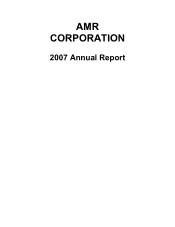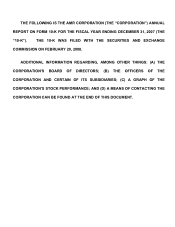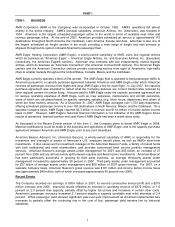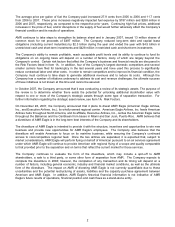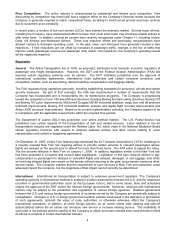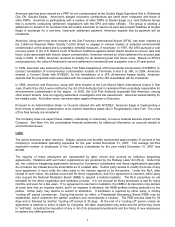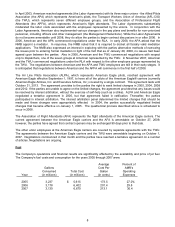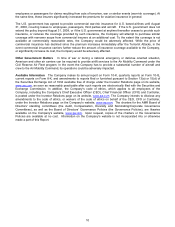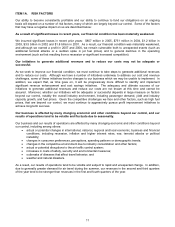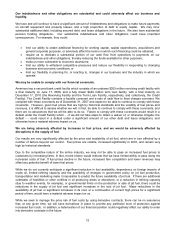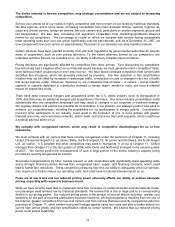American Airlines 2007 Annual Report Download - page 7
Download and view the complete annual report
Please find page 7 of the 2007 American Airlines annual report below. You can navigate through the pages in the report by either clicking on the pages listed below, or by using the keyword search tool below to find specific information within the annual report.
4
Price Competition The airline industry is characterized by substantial and intense price competition. Fare
discounting by competitors has historically had a negative effect on the Company’s financial results because the
Company is generally required to match competitors' fares, as failing to match would provide even less revenue
due to customers’ price sensitivity.
In recent years, a number of low-cost carriers (LCCs) have entered the domestic market. Several major airlines,
including the Company, have implemented efforts to lower their costs since lower cost structures enable airlines to
offer lower fares. In addition, several air carriers have recently reorganized under Chapter 11, including United,
Delta, US Airways and Northwest Airlines. These cost reduction efforts and bankruptcy reorganizations have
allowed carriers to decrease operating costs. In the past, lower cost structures have generally resulted in fare
reductions. If fare reductions are not offset by increases in passenger traffic, changes in the mix of traffic that
improve yields (passenger revenue per passenger mile) and/or cost reductions, the Company’s operating results
will be negatively impacted.
Regulation
General The Airline Deregulation Act of 1978, as amended, eliminated most domestic economic regulation of
passenger and freight transportation. However, the DOT and the Federal Aviation Administration (FAA) still
exercise certain regulatory authority over air carriers. The DOT maintains jurisdiction over the approval of
international codeshare agreements, international route authorities and certain consumer protection and
competition matters, such as advertising, denied boarding compensation and baggage liability.
The FAA regulates flying operations generally, including establishing standards for personnel, aircraft and certain
security measures. As part of that oversight, the FAA has implemented a number of requirements that the
Company has incorporated and is incorporating into its maintenance programs. The Company is progressing
toward the completion of over 180 airworthiness directives including Boeing fuel tank safety directives, Boeing 757
and Boeing 767 pylon improvements, McDonnell Douglas MD-80 horizontal stabilizer, cargo door and aft pressure
bulkhead improvements, Boeing 737 horizontal stabilizer actuator and digital flight recorder improvements and
Airbus A300 structural improvements. Based on its current implementation schedule, the Company expects to be
in compliance with the applicable requirements within the required time periods.
The Department of Justice (DOJ) has jurisdiction over airline antitrust matters. The U.S. Postal Service has
jurisdiction over certain aspects of the transportation of mail and related services. Labor relations in the air
transportation industry are regulated under the Railway Labor Act, which vests in the National Mediation Board
certain regulatory functions with respect to disputes between airlines and labor unions relating to union
representation and collective bargaining agreements.
On December 21, 2007, a New York federal judge dismissed the Air Transport Association‘s (“ATA”) challenge to
a recently enacted New York law requiring airlines to provide certain services to onboard passengers whose
flights are delayed on the ground prior to takeoff for more than three hours. The ATA plans to appeal the ruling.
The law became effective in New York on January 1, 2008. In addition, legislation similar to the New York law
has been proposed in Congress and several state legislatures. Legislation of this type requires airlines to pay
compensation to passengers for delayed or cancelled flights and delayed, damaged, or lost luggage; sets limits
on how long delayed flights can remain on the tarmac without returning to the gate; and presents numerous other
service issues. The Company expects that the requirement of such services in New York and elsewhere could
adversely impact the Company, but the magnitude of that impact cannot currently be determined.
International International air transportation is subject to extensive government regulation. The Company's
operating authority in international markets is subject to aviation agreements between the U.S. and the respective
countries or governmental authorities (such as the European Union), and in some cases, fares and schedules
require the approval of the DOT and/or the relevant foreign governments. Moreover, alliances with international
carriers may be subject to the jurisdiction and regulations of various foreign agencies. Bilateral agreements
between the U.S. and various foreign governments of countries served by the Company are periodically subject to
renegotiation. Changes in U.S. or foreign government aviation policies could result in the alteration or termination
of such agreements, diminish the value of route authorities, or otherwise adversely affect the Company's
international operations. In addition, at some foreign airports, an air carrier needs slots (landing and take-off
authorizations) before the air carrier can introduce new service or increase existing service. The availability of
such slots is not assured and the inability of the Company to obtain and retain needed slots could therefore inhibit
its efforts to compete in certain international markets.

